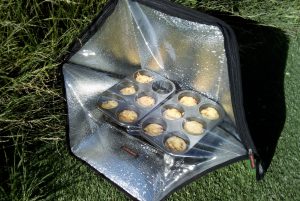Here’s a simple plan for low energy cooking: Upgrade your stovetop to an induction unit (yes, even renters can do this, we’ll show you how), treat the oven as a luxury or even supplement it with a solar oven and use a fireless cooker to make cooking easier.
Stovetop
- Electric stoves are usually the simplest to operate but do not offer the instant response of gas cooking.
- Induction also responds to cooking level changes as instantly as gas does, yet consumes less energy and is as simple to use as an electric stove.
- Induction stoves are simple to clean, heat up very quickly and don’t present a burn hazard like gas or electric stoves.
If you don’t have an induction stove top in your rental, don’t worry because we have an easy and cheap solution that is easy to move to another property if need be (see photo above).
- We use two portable induction hotplates that cost $50 each and have made a nice wooden benchtop to cover the gas stovetop that we are no longer using. This system took an hour to set up.
- Using portable hotplates is very convenient as we can spread them if we are using a frying pan and a big pot at the same time or the hotplates can even be used for outdoor cooking.
- In the kitchen, the power cords are directed neatly to a double power point nearby.

There’s just two things to consider when going down this route:
First, the magnetic induction process can heat metallic materials in the immediate vicinity of the hotplate (say a few centimetres from the hotplate) being used. If you locate your induction hotplates directly above a gas stovetop there must be a non-conductive barrier between the two.
We have tested our setup with the wooden benchtop and there is no noticeable temperature increase in the unused gas burners below.
The second thing to consider is if your cookware can work with an induction cooker. The base of the cookware must contain iron to give it magnetic properties.
Cookware that is suitable for induction should have a label stamped on it to say so. In some cases, if a magnet sticks to the base of the pot or pan, it will work, though it may not as effectively as induction ready cookware.
If you have to replace your cookware with induction ready cookware, it is not expensive at under $100 for a frying pan and three pots. Induction ready cookware works with all other stoves.

Whatever stovetop you use, here’s a few tips to cook up a storm with less energy:
- When boiling, only use as much water as you need. The same goes for the kettle; if we want two cups of tea, we fill two cups with cold water and put them in the kettle and only boil what we need.
- Make use of the lids of your pots and frying pan; they help to retain the heat in whatever you’re cooking.
- Make use of the residual heat in the frying pan or pot you are using. For example, if you plan to finish simmering or frying something in a few minutes, you can probably shut off the stove and let to the heat left in the pan finish the job.
Oven and solar oven

- We have a small solar oven that gets used for making muffins, bread, cooking eggs, cooking rice, sterilising jars for pickling and heating water for tea and pre heating water for cooking.
- It is light weight, stores away easily and doubles as our solar hot water heater.
- As long as the sun is strong enough to cast a shadow, the solar oven can reach temperatures of 100-110 degrees Celsius.
- We do have an electric oven that gets used occasionally which is a nice luxury though we try to avoid it as ovens knock off a fair bit of power.
Fireless cooker

- Sometimes we make use of a fireless cooker to make cooking easier. A fireless cooker is a device that retains heat so well in a pot that the cooking process continues without any additional energy input.
- There are commercially available vacuum sealed models but a simple version can be made using a thick blanket and a basket (which is what we use).
- A fireless cooker on average can reduce the need for cooking energy by 50% or more [1].
Using a fireless cooker is simple, just heat up a liquid or sauce based dish, boil it for a few minutes and then take it off the heat and put it straight into the fireless cooker. The remaining heat will finish the job.
Fireless cookers can be used for stews, casseroles, curries, bread, muffins, making pasta and rice.
Cooking times vary but the great thing is that while something is cooking in a fireless cooker, there is no need to supervise the process as nothing can boil over or start a fire.
Overall, using these methods together means that you can go gas free as a renter, use very little energy for cooking and even be able to maintain the ability to cook in a blackout situation with the use of a small backup stove.
Until we can get solar cookers with heat storage in Australia (they do exist, see link 2 below), this is a smart way to prepare food in a rental [2].
Further Reading:
[1] https://www.lowtechmagazine.com/2014/07/cooking-pot-insulation-key-to-sustainable-cooking.html [2] https://www.sunbuckets.com/